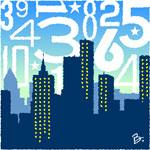Rent Regulation 101: Look Before You Lease
NOVEMBER 18, 2010
City and state rent regulation laws mean that your rental agreement may go well beyond the items that appear on your lease.
A look at this recent U.S. Census Bureau chart (via Matrix) outlining New York City’s living spaces reveals that a large percentage of homes in the five boroughs are rentals (75% in Manhattan). And between 29% (Queens) and 58% (Bronx)—50% in Manhattan—are rent-regulated.
Rent regulation refers to both rent stabilization and rent control programs. Rent stabilization applies to buildings built between 1947 and 1974 and limits the amount of rent tenants can be charged as well as covering issues like eviction and lease renewal. If you’re about to rent a stabilized apartment, ask for a Rent Stabilization Rider, which explains the rights and responsibilities of tenants and owners. You can find out more from housingnyc.com and the city’s NYC Affordable Housing Resource Center.
Rent control also limits the rent that an owner can charge and restricts eviction, but it only applies to buildings that were built before 1947. To qualify for rent control, a tenant (or family member) must have been living continuously in an apartment since July 1, 1971. Once the original tenant vacates an apartment, it becomes decontrolled.
In February of 2009, the State Assembly passed a package of rent-regulation legislation which could continue or reinstate regulation status on a significant number of city apartments that have been converted to market rate (via NY Times).
ALSO IN NEW YORK CITY INSIDER
- 30 Park Place Vs. The Baccarat Hotel and Residences - JUL 8, 2014
- This Week in NYC Living - JUL 1, 2014
- Notable NYC Neighbors - JUN 26, 2014
- Great NYC Buildings: New in the Heights - JUN 23, 2014
- Notable NYC Neighbors - JUN 20, 2014
- Notable NYC Neighbors - JUN 17, 2014
- Building Vs. Building - JUN 9, 2014
- Notable NYC Neighbors - JUN 6, 2014
- Notable NYC Neighbors - MAY 23, 2014
- Notable NYC Neighbors - MAY 15, 2014
- Great NYC Apartment Buildings: 12 East 13th Street vs. 22 Central Park South - MAY 13, 2014
- Notable NYC Neighbors - MAY 7, 2014
- Notable NYC Neighbors - MAY 1, 2014
- Upping the Architectural Ante in NoHo - APR 22, 2014
- Great NYC Buildings: Brooklyn's Gold Coast Living - APR 15, 2014
- Notable NYC Neighbors - APR 11, 2014
- Building vs. Building - APR 10, 2014
- Notable NYC Neighbors - APR 2, 2014
- This Week in NYC Living - APR 1, 2014
- Notable NYC Neighbors - MAR 26, 2014
- View Articles By Date


 6sqft delivers the latest on real estate, architecture, and design, straight from New York City.
6sqft delivers the latest on real estate, architecture, and design, straight from New York City.
